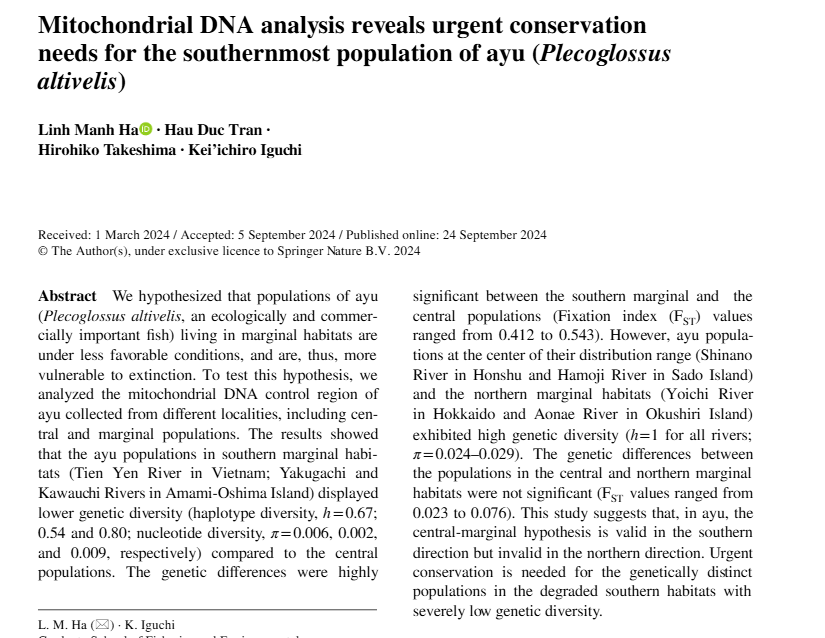HIGHLIGHT
Mitochondrial DNA analysis reveals urgent conservation needs for the southernmost population of ayu (Plecoglossus altivelis)
By Linh Manh Ha, Hau Duc Tran, Hirohiko Takeshima & Kei'ichiro Iguchi

By Linh Manh Ha, Hau Duc Tran, Hirohiko Takeshima & Kei'ichiro Iguchi
We hypothesized that populations of ayu (Plecoglossus altivelis, an ecologically and commercially important fish) living in marginal habitats are under less favorable conditions, and are, thus, more vulnerable to extinction. To test this hypothesis, we analyzed the mitochondrial DNA control region of ayu collected from different localities, including central and marginal populations. The results showed that the ayu populations in southern marginal habitats (Tien Yen River in Vietnam; Yakugachi and Kawauchi Rivers in Amami-Oshima Island) displayed lower genetic diversity (haplotype diversity, h = 0.67; 0.54 and 0.80; nucleotide diversity, π = 0.006, 0.002, and 0.009, respectively) compared to the central populations. The genetic differences were highly significant between the southern marginal and the central populations (Fixation index (FST) values ranged from 0.412 to 0.543). However, ayu populations at the center of their distribution range (Shinano River in Honshu and Hamoji River in Sado Island) and the northern marginal habitats (Yoichi River in Hokkaido and Aonae River in Okushiri Island) exhibited high genetic diversity (h = 1 for all rivers; π = 0.024–0.029). The genetic differences between the populations in the central and northern marginal habitats were not significant (FST values ranged from 0.023 to 0.076). This study suggests that, in ayu, the central-marginal hypothesis is valid in the southern direction but invalid in the northern direction. Urgent conservation is needed for the genetically distinct populations in the degraded southern habitats with severely low genetic diversity.
Special notification from Ha Linh
Not vailable
OTHER RECENT PUBLICATIONS
Artificial breeding and larval rearing techniques to conserve ayu, Plecoglossus altivelis (Plecoglossidae)
By Linh Manh Ha & Kei'ichiro Iguchi

Ex-situ conservation, which is important to protect critically endangered species, requires special artificial breeding and rearing techniques during the early life stages of a species. This study describes the artificial breeding and larval rearing techniques to conserve ayu (Plecoglossus altivelis), an important fish that is endangered in some locations. Fish eggs and milt were acquired from mature fish by gently pressing the fish abdomen; subsequently, artificial insemination was performed by gentle mixing. The fertilized eggs were then incubated in running freshwater (for approximately 14 days). After hatching, the larvae were placed in brackish water (ca. 10‰ salinity; 7-8 mg L-1 dissolved oxygen) to maintain live food to the larvae. From the 1st to 35th day after hatching (DAH), the larvae were fed with live rotifers. Subsequently, from the 15th DAH onwards, the larvae were fed with brine shrimp nauplii along with rotifers and were familiarized with artificial food. After the fish gained a body length of 4-5 cm and started consuming 0.5-0.8 mm formulated food grain, they were transferred to a fingerling nursery with freshwater for further cultivation. This study also noticed that the susceptible stages of ayu larvae were at approximately 14-16th and 40-45th DAH. This work provides necessary information to design a conservation plan for the ayu population in the southern distribution range of this species where it is currently facing threats of extinction, such as in Vietnam. Additionally, the study describes the rotifer culturing technique that can assist in conducting larviculture.
If you have interest with this paper, you can read it freely at This NEW PAPER
A three pelvic fins fish: a very rare mutation
By Linh Manh Ha & Kei'ichiro Iguchi

Our newly published study describes a fish individual of Plecoglossus altivelis ryukyuensis with three pelvic fins collected from a hatchery-reared population in Amami-oshima Island, Japan. The additional pelvic fin had the same number of rays as the neighboring pelvic fins (eight fin rays), and its girdle was fused with that of the neighbor. The comparison of morphometric measurements and meristic counts of the abnormal specimen with those of the normal specimens revealed that this abnormality was not a syndrome when all other characteristics were in the expected ranges. The condition factor of abnormal fish was close to the ideal value, suggesting that this abnormality did not severely affect the activities of the fish under rearing conditions. Well-managed rearing conditions might contribute significantly to the survival and growth of abnormal fish. The cause of this abnormality is unclear, but the limited diversity in the genome of the subspecies is assumed to be a probable factor.
If you have interest with this paper, you can read it freely at This Link.

